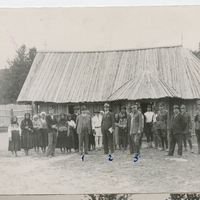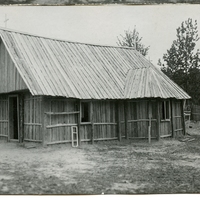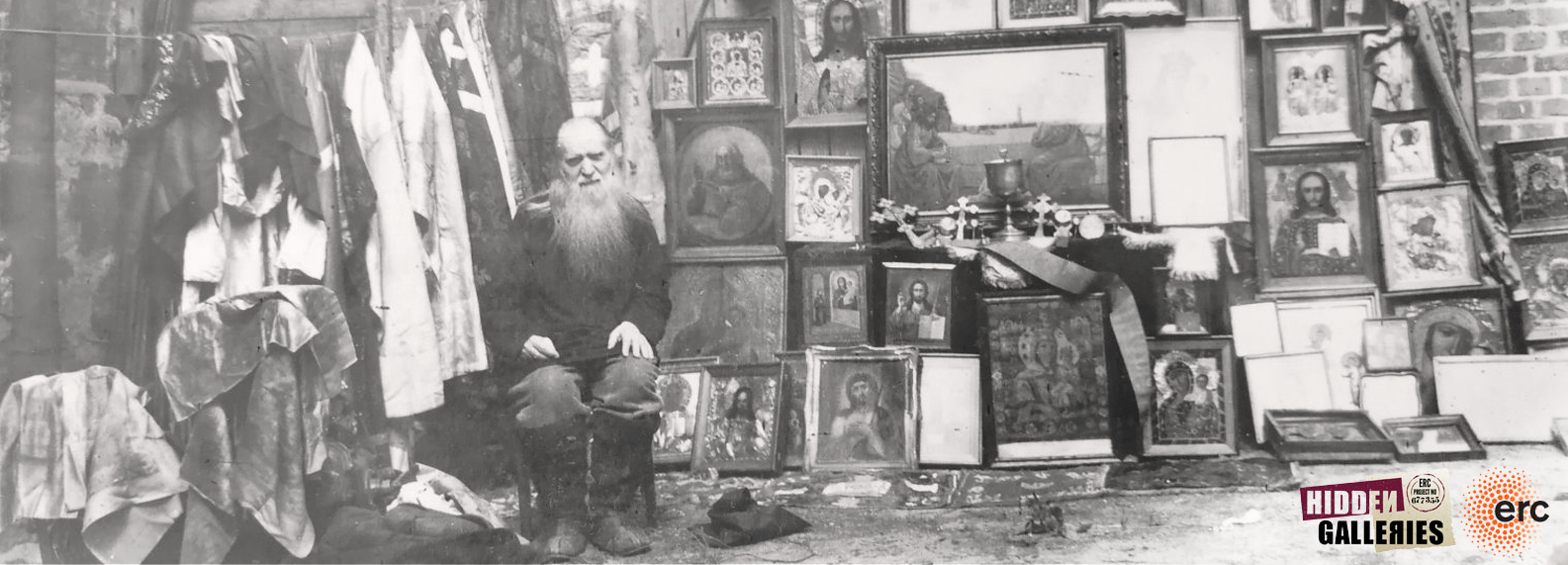Destruction of Romanian Old Calendarist Church in Cucova
Item
Title
Destruction of Romanian Old Calendarist Church in Cucova
Distrugerea bisericii vechi calendariste din Cucova România
Description
These photographs were taken in 1935, in the village of Cucova, in the county of Putna (nowadays Bacău), as evidence of the rebellions and problems caused by the Old Calendarists in the region. The term "Stilists" was also used by the state and the press in order to label them, referring to the fact that they were following the "old style" dates and calendar.
The first image depicts some gendarmes, a few members of civil authorities and mainly women members of the Old Calendarist community, all of whom were arrested. The photograph was taken in front of the Old Calendarist wooden church, which was also surrounded by a wooden fence. The number of women depicted in this photograph supports the contemporary view that women played an important role in the Old Calendarist communities. The same assertion is supported by both secret police reports and numerous newspaper articles that accuse Old Calendarist women of attempting to lure and trick people into becoming members of the community.
The second photograph offers a clear picture of the wooden church and the surrounding fence. The window frames of the church appear to have been removed, which could indicate the intention of the authorities to completely destroy it but keep the valuable material. According to the narratives of the Old Calendarists, the church was destroyed soon after this event.
The third photo depicts the interior of the church and is of great value due to the fact that it allows us to see how objects and icons were originally displayed. It was taken from the inside of the church and captures the intrusive gaze of the three gendarmes (shown in the centre of the photo) into the sacred space. Large icons appear to have been removed from the wall and there are other numerous small icons. The random character of the small lithograph objects suggests that they were donated by members of the community.
The events at Cucova, that were labelled by the authorities as rebellions, were part of a general religious dissent that began with the introduction of the calendar reform in Romania. It gave birth to a movement in the Eastern Romanian provinces of Moldova and Bessarabia which became known as Old Calendarists or Stilists, after the Romanian term “old style,” referring to their opposition towards the acceptance of the new Gregorian calendar.
The context in which these photographs were taken is a very important one, especially for the history of the Old Calendarist church. The incidents that took place in Cucova, in 1935, are described as a massacre in various narratives of the Old Calendarists, while the archival documents portray the event in a different light, making the Old Calendarists appear as rebels and troublemakers. Even though it is not very clear what caused the incident, the fact that Cucova became a point of attraction for Old Calendarists from different places might have been a reason for the authorities’ intervention. Police reports mention that the Old Calendarist believers hid in their improvised church and soon became violent, forcing the Gendarmerie to use firearms. Based on some archival documents and other sources, five people were killed, 28 wounded and 40 arrested.
In 1936, one year after this event, police reports state that the Stilist movement was no longer active in the region. Even though the wooden church in Cucova was destroyed in 1935, an Old Calendarist monastery was later rebuilt on the approximately same place, where it still stands today.
These images can be found in the file CNSAS, D 015305. Apart from these 3 images, it contains 6 more photographs depicting what happened in Cucova, as well as more documents regarding the problems generated by the changing of the calendar, especially among the peasants.
For further readings see:
Andreea PETRUESCU, Mișcarea stilistă în Basarabia, 1935-1936. Cauze și soluții. Perspective locale (Stylist movement in Bessarabia, 1935-1936. Causes and solutions. Local perspectives), in Caietele CNSAS, Anul IX, nr. 1-2 (17-18)/2016, Editura CNSAS, Bucureşti, 2017.
”Anchetarea rebeliunii stiliste din Piatra Neamț” in Dimineața, No. 10683, September 19,1936,
”Femeile au un rol important în mișcarea stilistă” in Capitala, No.191, September 24, 1936.
”Încăierare cu stiliștii într-o comună din județul Putna. Doi morți și șapte răniți” in Universul, May 29, 1935.
For related entries see:
The first image depicts some gendarmes, a few members of civil authorities and mainly women members of the Old Calendarist community, all of whom were arrested. The photograph was taken in front of the Old Calendarist wooden church, which was also surrounded by a wooden fence. The number of women depicted in this photograph supports the contemporary view that women played an important role in the Old Calendarist communities. The same assertion is supported by both secret police reports and numerous newspaper articles that accuse Old Calendarist women of attempting to lure and trick people into becoming members of the community.
The second photograph offers a clear picture of the wooden church and the surrounding fence. The window frames of the church appear to have been removed, which could indicate the intention of the authorities to completely destroy it but keep the valuable material. According to the narratives of the Old Calendarists, the church was destroyed soon after this event.
The third photo depicts the interior of the church and is of great value due to the fact that it allows us to see how objects and icons were originally displayed. It was taken from the inside of the church and captures the intrusive gaze of the three gendarmes (shown in the centre of the photo) into the sacred space. Large icons appear to have been removed from the wall and there are other numerous small icons. The random character of the small lithograph objects suggests that they were donated by members of the community.
The events at Cucova, that were labelled by the authorities as rebellions, were part of a general religious dissent that began with the introduction of the calendar reform in Romania. It gave birth to a movement in the Eastern Romanian provinces of Moldova and Bessarabia which became known as Old Calendarists or Stilists, after the Romanian term “old style,” referring to their opposition towards the acceptance of the new Gregorian calendar.
The context in which these photographs were taken is a very important one, especially for the history of the Old Calendarist church. The incidents that took place in Cucova, in 1935, are described as a massacre in various narratives of the Old Calendarists, while the archival documents portray the event in a different light, making the Old Calendarists appear as rebels and troublemakers. Even though it is not very clear what caused the incident, the fact that Cucova became a point of attraction for Old Calendarists from different places might have been a reason for the authorities’ intervention. Police reports mention that the Old Calendarist believers hid in their improvised church and soon became violent, forcing the Gendarmerie to use firearms. Based on some archival documents and other sources, five people were killed, 28 wounded and 40 arrested.
In 1936, one year after this event, police reports state that the Stilist movement was no longer active in the region. Even though the wooden church in Cucova was destroyed in 1935, an Old Calendarist monastery was later rebuilt on the approximately same place, where it still stands today.
These images can be found in the file CNSAS, D 015305. Apart from these 3 images, it contains 6 more photographs depicting what happened in Cucova, as well as more documents regarding the problems generated by the changing of the calendar, especially among the peasants.
For further readings see:
Andreea PETRUESCU, Mișcarea stilistă în Basarabia, 1935-1936. Cauze și soluții. Perspective locale (Stylist movement in Bessarabia, 1935-1936. Causes and solutions. Local perspectives), in Caietele CNSAS, Anul IX, nr. 1-2 (17-18)/2016, Editura CNSAS, Bucureşti, 2017.
”Anchetarea rebeliunii stiliste din Piatra Neamț” in Dimineața, No. 10683, September 19,1936,
”Femeile au un rol important în mișcarea stilistă” in Capitala, No.191, September 24, 1936.
”Încăierare cu stiliștii într-o comună din județul Putna. Doi morți și șapte răniți” in Universul, May 29, 1935.
For related entries see:
Aceste fotografii au fost făcute în anul 1935, în satul Cucova din județul Putna (astăzi Bacău), ca dovadă a rebeliunilor și problemelor cauzate de vechii calendariști din regiune. Termenul de „stiliști” era folosit de stat sau de presa vremii pntru a-i denumi pe aceștia, referindu-se la faptul că foloseau calendarul de „stil vechi.”
Prima imagine prezintă niște jandarmi, câțiva membri ai autorităților civile, precum și membri ai comunității vechi calendariste, dintre care majoritatea a fost arestată. Fotografia a fost făcută în fața bisericii de lemn a comunității, aceasta fiind înconjurată și de un gard de lemn. Numărul semnificativ al femeilor prezente în fotografii susține viziunea contemporană conform căreia femeile au jucat un rol important în comunitățile vechi calendariste. Aceeași afirmație este făcută și de rapoartele poliției secrete și numeroasele articole din ziare, acestea acuzând femeile vechi calendariste că încercau să îi atragă pe oameni în cadrul mișcării.
Cea de a doua fotografie oferă o imagine clară a bisericii de lemn și a gardului de lemn ce o înconjura. Ramele ferestrelor bisericii par să fi fost înlăturate, ceea ce indică intenția autorităților de a o distruge complet, dorind, totuși, să păstreze materialul de valoare. Conform literaturii Bisericii Ortodoxe Române de Stil Vechi, biserica a fost ditrusă la scurt timp după acest eveniment. Cea de a treia fotografie prezintă interiorul bisericii și este de mare valoare datorită faptului că ne permite să observăm modul în care obiectele și icoanele erau aranjate inițial. Fotografia a fost făcută din interiorul bisericii și surprinde privirea invazivă a celor trei jandarmi (apar în mijlocul pozei) în spațiul sacru al bisericii. Icoane de mari dimensiuni par să fi fost înlăturate de pe perete, rămânând alte icoane de dimensiuni mai mici. Diversitatea de stil și dimensiune a acestor icoane sugerează faptul că acestea au fost, cel mai probabil, donate de membrii comunității.
Evenimentele de la Cucova, descrise de către autorități ca și rebeliuni, au fost efectul unui fenomen religios de opoziție ce a început cu ocazia adoptării reformei calendarului de către Biserica Ortodoxă din România. Aceasta a declanșat o mișcare ce s-a manifestat mai ales în proviniciile de răsărit ale României, Moldova și Basarabia, care a ajuns să fie cunoscută drept vechi calendaristă sau „stilistă”, după termenul de „stil vechi”, făcând referire la opoziția lor față de calendarul gregorian.
Contextul în care aceste fotografii au fost făcute este unul foarte important, mai ales pentru istoria bisericii vechi calendariste. Evenimentele ce au avut loc la Cucova în anul 1935 sunt catalogate drept masacre în numeroasele narațiuni ale vechilor calendariști, în timp ce documentele de arhivă îl prezintă într-o lumină extrem de diferită, făcându-i pe vechii calendariști să pară rebeli și cauzatori de probleme. Deși nu este foarte evident ce anume a generat acest incident, faptul că biserica din Cucova a devenit un punct de atracție pentru vechii calendariști din numeroase locuri poate să fi cauzat intervenția autorităților. Rapoartele poliției menționează faptul că toți credincioșii s-au ascuns în biserică, devenind violenți și forțând Jandarmeria să folosească armele. Conform unor documente de arhivă și altor surse, cinci oameni au fost uciși, 28 răniți și 40 arestați.
În 1936, la un an după acest eveniment, rapoartele poliției vorbesc despre faptul că „mișcarea stilistă” nu mai era activă în regiune. Deși biserica de lemn din Cucova a fost distrusă în anul 1935, o mănăstire vechi calendaristă a fost reconstruită pe aproximativ același loc, unde se află și astăzi.
Aceste imagini se află în CNSAS, D 015305. Pe lângă cele trei imagini, dosarul mai conține încă 6 fotografii ce surprind ceea ce s-a întâmplat la Cucova, precum și alte documente ce fac referire la problemele generate de schimbarea calendarului, mai ales în rândul țăranilor.
Pentru informații suplimentare vezi:
Andreea PETRUESCU, Mișcarea stilistă în Basarabia, 1935-1936. Cauze și soluții. Perspective locale (Stylist movement in Bessarabia, 1935-1936. Causes and solutions. Local perspectives), in Caietele CNSAS, Anul IX, nr. 1-2 (17-18)/2016, Editura CNSAS, Bucureşti, 2017.
”Anchetarea rebeliunii stiliste din Piatra Neamț” in Dimineața, No. 10683, September 19,1936,
”Femeile au un rol important în mișcarea stilistă” in Capitala, No.191, September 24, 1936.
”Încăierare cu stiliștii într-o comună din județul Putna. Doi morți și șapte răniți” in Universul, May 29, 1935.
Pentru descrieri similate vezi:
Prima imagine prezintă niște jandarmi, câțiva membri ai autorităților civile, precum și membri ai comunității vechi calendariste, dintre care majoritatea a fost arestată. Fotografia a fost făcută în fața bisericii de lemn a comunității, aceasta fiind înconjurată și de un gard de lemn. Numărul semnificativ al femeilor prezente în fotografii susține viziunea contemporană conform căreia femeile au jucat un rol important în comunitățile vechi calendariste. Aceeași afirmație este făcută și de rapoartele poliției secrete și numeroasele articole din ziare, acestea acuzând femeile vechi calendariste că încercau să îi atragă pe oameni în cadrul mișcării.
Cea de a doua fotografie oferă o imagine clară a bisericii de lemn și a gardului de lemn ce o înconjura. Ramele ferestrelor bisericii par să fi fost înlăturate, ceea ce indică intenția autorităților de a o distruge complet, dorind, totuși, să păstreze materialul de valoare. Conform literaturii Bisericii Ortodoxe Române de Stil Vechi, biserica a fost ditrusă la scurt timp după acest eveniment. Cea de a treia fotografie prezintă interiorul bisericii și este de mare valoare datorită faptului că ne permite să observăm modul în care obiectele și icoanele erau aranjate inițial. Fotografia a fost făcută din interiorul bisericii și surprinde privirea invazivă a celor trei jandarmi (apar în mijlocul pozei) în spațiul sacru al bisericii. Icoane de mari dimensiuni par să fi fost înlăturate de pe perete, rămânând alte icoane de dimensiuni mai mici. Diversitatea de stil și dimensiune a acestor icoane sugerează faptul că acestea au fost, cel mai probabil, donate de membrii comunității.
Evenimentele de la Cucova, descrise de către autorități ca și rebeliuni, au fost efectul unui fenomen religios de opoziție ce a început cu ocazia adoptării reformei calendarului de către Biserica Ortodoxă din România. Aceasta a declanșat o mișcare ce s-a manifestat mai ales în proviniciile de răsărit ale României, Moldova și Basarabia, care a ajuns să fie cunoscută drept vechi calendaristă sau „stilistă”, după termenul de „stil vechi”, făcând referire la opoziția lor față de calendarul gregorian.
Contextul în care aceste fotografii au fost făcute este unul foarte important, mai ales pentru istoria bisericii vechi calendariste. Evenimentele ce au avut loc la Cucova în anul 1935 sunt catalogate drept masacre în numeroasele narațiuni ale vechilor calendariști, în timp ce documentele de arhivă îl prezintă într-o lumină extrem de diferită, făcându-i pe vechii calendariști să pară rebeli și cauzatori de probleme. Deși nu este foarte evident ce anume a generat acest incident, faptul că biserica din Cucova a devenit un punct de atracție pentru vechii calendariști din numeroase locuri poate să fi cauzat intervenția autorităților. Rapoartele poliției menționează faptul că toți credincioșii s-au ascuns în biserică, devenind violenți și forțând Jandarmeria să folosească armele. Conform unor documente de arhivă și altor surse, cinci oameni au fost uciși, 28 răniți și 40 arestați.
În 1936, la un an după acest eveniment, rapoartele poliției vorbesc despre faptul că „mișcarea stilistă” nu mai era activă în regiune. Deși biserica de lemn din Cucova a fost distrusă în anul 1935, o mănăstire vechi calendaristă a fost reconstruită pe aproximativ același loc, unde se află și astăzi.
Aceste imagini se află în CNSAS, D 015305. Pe lângă cele trei imagini, dosarul mai conține încă 6 fotografii ce surprind ceea ce s-a întâmplat la Cucova, precum și alte documente ce fac referire la problemele generate de schimbarea calendarului, mai ales în rândul țăranilor.
Pentru informații suplimentare vezi:
Andreea PETRUESCU, Mișcarea stilistă în Basarabia, 1935-1936. Cauze și soluții. Perspective locale (Stylist movement in Bessarabia, 1935-1936. Causes and solutions. Local perspectives), in Caietele CNSAS, Anul IX, nr. 1-2 (17-18)/2016, Editura CNSAS, Bucureşti, 2017.
”Anchetarea rebeliunii stiliste din Piatra Neamț” in Dimineața, No. 10683, September 19,1936,
”Femeile au un rol important în mișcarea stilistă” in Capitala, No.191, September 24, 1936.
”Încăierare cu stiliștii într-o comună din județul Putna. Doi morți și șapte răniți” in Universul, May 29, 1935.
Pentru descrieri similate vezi:
Subject
Religion and State--Europe
Religion -- History -- 20th century
Icons
Surveillance
Rebellions
Romania.Siguranța
Nationalism--Romania--History
Secret police (secret service)
Religion and Politics-- Europe
Religion -- History -- 20th century
Communism and Christianity
Communism and Christianity--Europe, Eastern
Communism and religion
Communism--Europe
Communism--Europe--History
Communism--Europe--History--20th century
Communism--Europe, Eastern
Communism--Europe, Eastern--History--20th century
Communism--History--20th century
Spies
Surveillance
Totalitarianism
Material culture--Religious aspects
Religious groups
Creator
Iuliana Cindrea
Source
Consiliul Național pentru Studierea Arhivelor Securității
CNSAS, D 015305
CNSAS, D 015305
Publisher
This project has received funding from the European Research Council (ERC) under the European Union’s Horizon 2020 research and innovation programme No . 677355
Date
1935
Rights
Copyright for these images belongs to CNSAS
Consiliul Național pentru Studierea Arhivelor Securității
Consiliul Național pentru Studierea Arhivelor Securității
Format
Image/ jpg
Photo
Language
RO
Type
Image
Identifier
CNSAS, D 015305
Coverage
20th Century, inter-war, Romania
Bibliographic Citation
Iuliana Cindrea, "Destruction of Romanian Old Calendarist Church in Cucova"
Date Created
2018
 Gendarmes and members of the Old Calendarist community in Cucova
Gendarmes and members of the Old Calendarist community in Cucova  The Old Calendarist wooden church
The Old Calendarist wooden church  The interior of the Old Calendarist wooden church
The interior of the Old Calendarist wooden church 